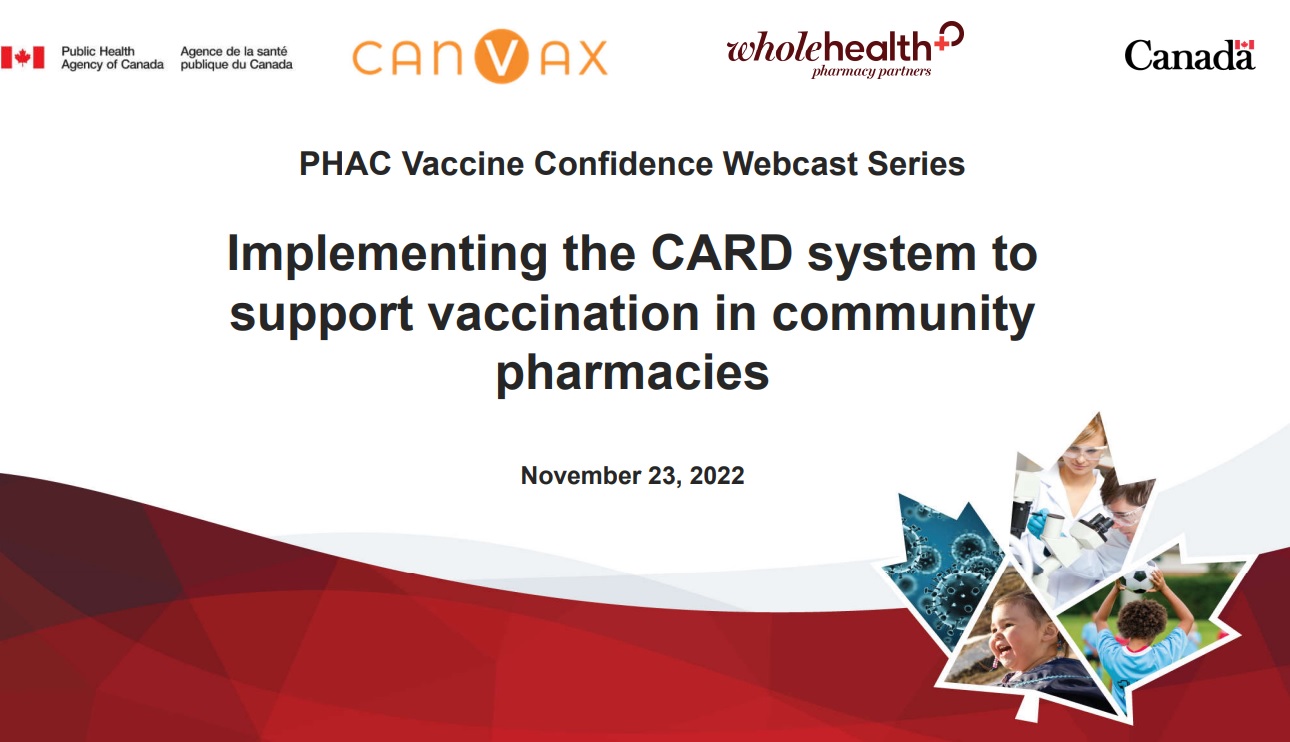Public Health Agency of Canada Vaccine Confidence Webcast Series: Implementing the CARD (comfort-ask-relax-distract) system to support vaccination in community pharmacies
Download in PDF format
(3.54 MB, 36 pages)
Organization: Public Health Agency of Canada in partnership with the Canadian Vaccination Evidence Resource and Exchange Center (CANVax)
Recorded for health care professionals: 2022-11-23
Related links
Objectives
At the end of this webcast, you will be able to:
- identify opportunities and strategies to implement the CARD system in your practice
- discuss the potential benefits for patients and staff in improving the vaccination experience
- recognize the importance and usefulness of the CARD system to support vaccination in pharmacy settings
What is the CARD system?
Speakers
James Morrison BScPhm, RPh; Director, Pharmacy Excellence
Acknowledgements
Funding and support
- Canadian Institutes of Health research
- Public Health Agency of Canada
- University of Toronto, the Leslie Dan Faculty of Pharmacy, lead researcher, Dr. Anna Taddio
Partners
- Help Eliminate Pain in Kids and Adults
- Immunize Canada
- Anxiety Canada
- AboutKidsHealthCanada.ca
- Pediatric Pain, Heath and Communication Lab
The University of Toronto holds a Section 9 Trademark number 924835 for CARD.
Why is addressing needle fear and anxiety important?
- Vaccines are the most common reason why people receive needles.
- Pain is the most common adverse event associated with immunization.
- Two-thirds of children and one-fourth adults are afraid of needles.
- Fear can fuel pain and lead to immunization stress-related responses such as dizziness, headache, nausea and fainting.
- Negative vaccination experiences contribute to negative attitudes about vaccination and to vaccine hesitancy.
- Up to 1 person in every 10 refuse vaccinations because of fear or pain.
Evidence
In 2015, the Canadian Clinical Practice Guideline (CPG) was created. It has been incorporated into the Canadian Immunization Guide and adopted by the World Health Organization.
The CPG includes evidence-based recommendations for reducing pain, fear and fainting. There are 5 domains of recommendations known as the 5Ps:
- Procedural
- Physical
- Pharmacologic
- Psychological
- Process
CARD framework
- Targets all stakeholders involved in vaccination
- Translates the 5Ps of pain management into a user-friendly tool
- Improves the vaccination experience by allowing stakeholders to 'play their CARDs'
What CARD looks like in a community pharmacy
The 4E model means the following.
Education
- Educate health care providers, vaccine clients, and caregivers ahead of time and on vaccination day.
- Offer posters and handouts outlining CARD approach.
- Distribute checklist with CARD options, patient preferences.
Environment
- Allow for privacy.
- Offer distractions.
- Provide seating for everyone, including support person.
- Minimize auditory and visual fear cues (ex: sharps bins hidden).
Engagement
- Be calm and positive to promote coping.
- Assess the client's signs and symptoms (fear, pain, fainting).
- Invite participation, answer questions.
- Support CARD (coping) choices.
- Minimize injection pain.
Evaluation
- Task specific staff with handing these out.
- Provide surveys at the same time as check-in.
CARD system in community pharmacy
A CARD implementation project was conducted in collaboration with Whole Health Pharmacy Partners.
Findings from this project will be reviewed along with key learnings for community pharmacy implementation.
Methods
Design
Before and after study.
Setting and participants
Five independent community pharmacies in southern Ontario offering COVID-19 vaccinations to children aged 5 to 11 years old.
Procedures
Before (control) phase; no changes to practices.
After phase (CARD); integration of CARD.
Methods, based on the 4Es
CARD interventions
- Environment: posters, distraction kits, privacy
- Education: immunizer training, CARD client coping checklist
- Engagement: reducing fear cues, supporting coping choices
Evaluation
- Children and parents completed surveys about pain and fear, experiences relative to the last needle, and how much CARD helped.
- Vaccinators provided quantitative and qualitative feedback.
Environmental changes to the waiting area

Figure 1: Text description
This pharmacy is a larger format premises with a waiting area and clinic rooms available.
The before picture shows a nearly bare waiting room with an assortment of health awareness posters affixed to the windows and a bulletin board.
In the after picture, there are CARD posters, one of which explains CARD in patient friendly language and another that is a search and find activity that children and families can try. The bright colours and characters make the pharmacy welcoming for children. In this photo, you can also see a cart carrying various distraction items, such as:
- colouring pages and crayons
- maze games from the dollar store
- fuzzy pipe cleaners
- candy
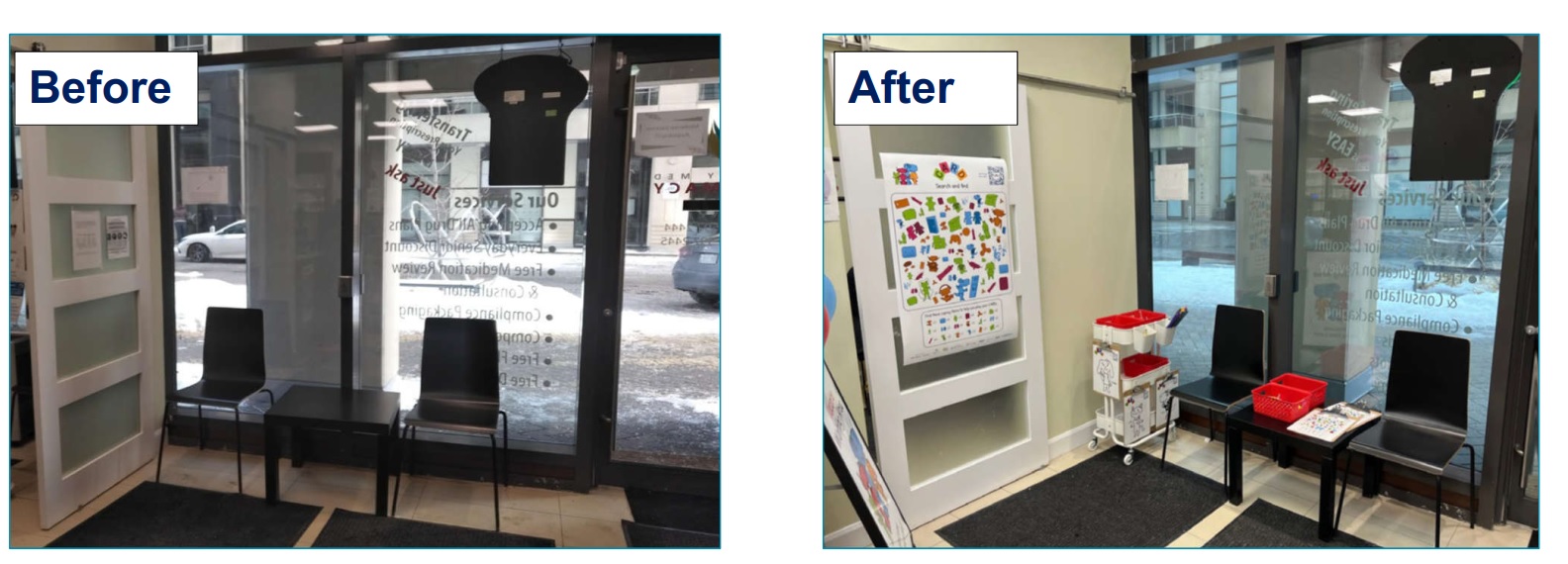
Figure 2: Text description
These pictures show the location is much smaller in contrast to the first pharmacy.
In the before picture, the waiting room is completely bare and the door to the vaccination room is open.
In the after picture, CARD posters were added to the small waiting area and included the distraction items on the cart and the table. The door to the vaccination room is also closed for privacy.
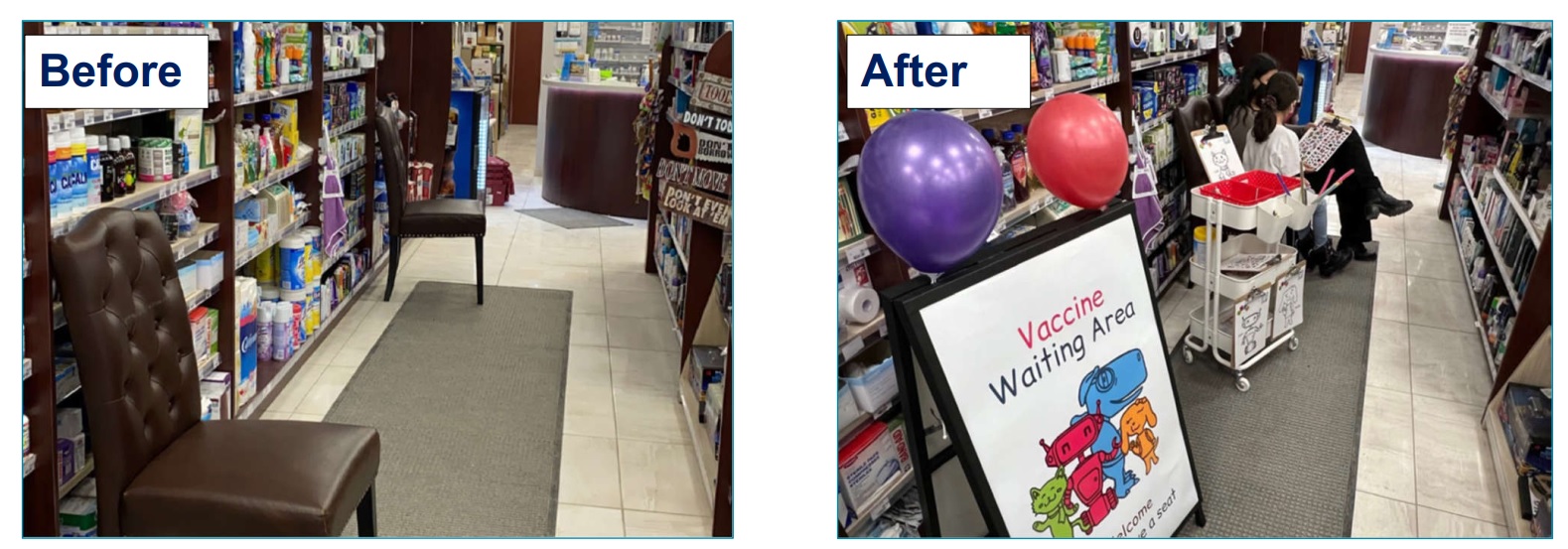
Figure 3: Text description
This location does not have a typical waiting area. Their process has the next person waiting for their appointment in the aisles of the pharmacy.
The before picture shows a pharmacy aisle with 2 chairs that are spread far apart with items for purchase stocked on the shelves.
The after picture shows that there is still an opportunity to implement CARD even in places without a waiting area. During the vaccination clinic, the easel with CARD posters and the distraction items on a cart were included. Chairs were also moved to be close to each other, so a child and their parent could sit together using the distraction items.
Environmental changes to the vaccination area
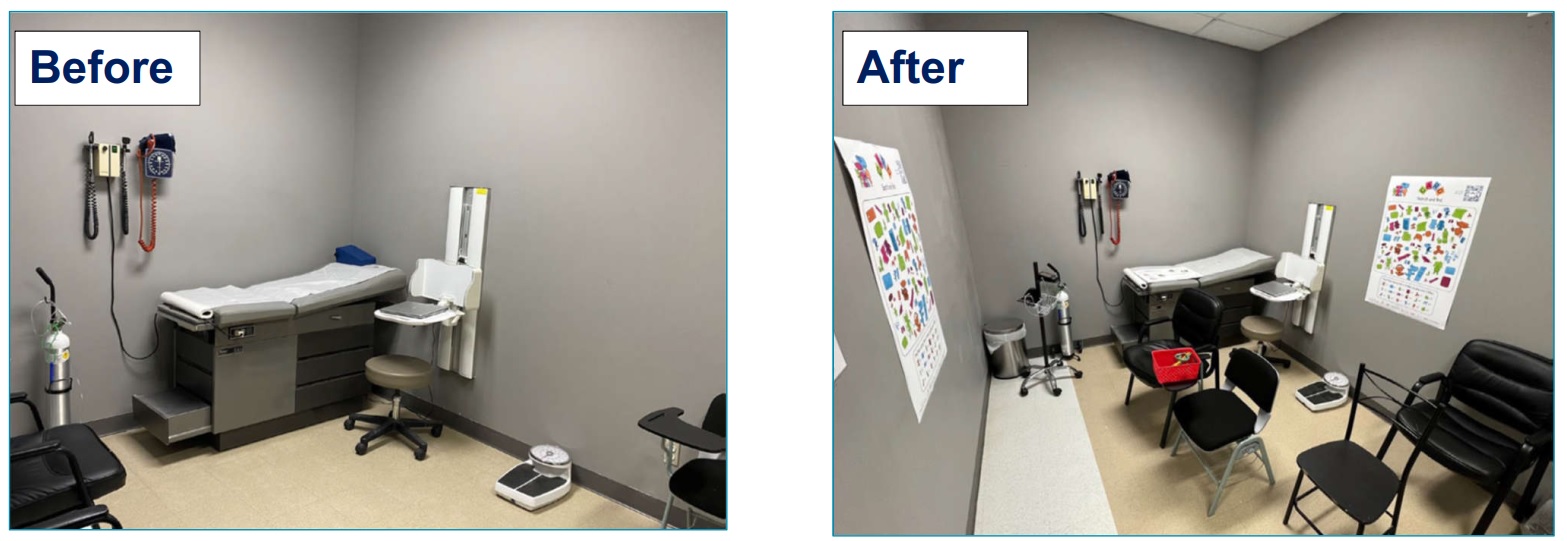
Figure 4: Text description
The before picture shows a vaccination room with just medical equipment and the patient chair pointing toward the equipment.
The after picture shows how the vaccination room was carefully re-oriented so that children were facing towards CARD posters, away from scary medical equipment, and away from where vaccinators may have equipment. The chair for children is facing in such a way that they will not see the vaccinator approach with the needle.
There is also a seat for a parent, the child in the middle, and the vaccinator to the left of the child. The vaccinator has a seat next to the child in order to conceal the needle as much as possible, and to omit alcohol swabbing or skin cleansing from the injection procedure.
The door to the vaccination area is also closed in the CARD intervention to provide privacy.
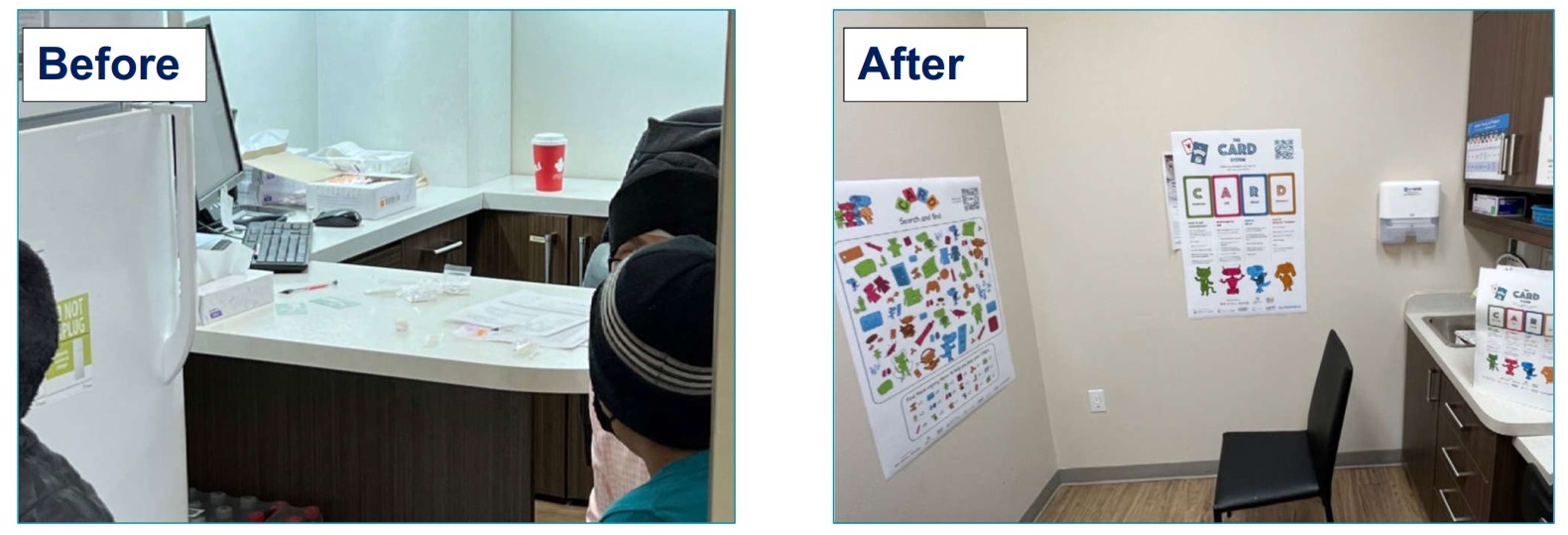
Figure 5: Text description
The before picture shows a pharmacy that was using a very small consultation room out in the open which became quite crowded when the immunizer was providing the vaccine to the child. Additionally, there was no space for a parent to support the child and they would stand in the open doorway. There's a desk that takes up most of the space with people sitting in front of it while they wait. There are visible needles and other equipment on the table that are fear cues.
In the after picture, the vaccination area was moved to a treatment room in the adjoining clinic. The child's chair is oriented to look towards CARD materials and away from the sharps container which is behind the smaller CARD poster on the right. The vaccinator concealed needles to avoid making children more fearful.

Figure 6: Text description
In the before picture, there is a smaller format pharmacy that has a modern consultation space adjacent to the dispensary. There is an assortment of health awareness posters affixed to the window, with medical equipment clearly visible on the desk. The desk is against the left wall facing the door. The chairs are against the walls and face toward the centre of the room. The door is open.
In the after picture, the room is transformed in preparation for CARD implementation. CARD posters are now affixed to the window and the patient chair is facing the window. The desk is against the window and is cleared of medical equipment and now displays distraction items. The setup allows the immunizer to approach from behind the child so that the needle is not visible. The door is closed.
Coping interventions

Figure 7: Text description
These 2 pictures show some of the coping interventions that were made available during the study. Items were included that would not add significant cost to pharmacies that would implement CARD, such as:
- inexpensive puzzle games
- pipe cleaners
- crayons
- colouring pages
- candy
CARD checklist
"The difference of having this piece of paper in front of me, prior to giving the vaccination, it gives me a lot of perspective already as to what this child would prefer."

Figure 8: Text description
What cards are you playing today?
We use the CARD (comfort, ask, relax, distract) system to help make you more comfortable during your vaccination. Fill in the CARD survey below to tell us how we can make your vaccination a more positive experience. If you should like to use a strategy that is not listed, let us know and we will try to do it. To learn more about CARD visit CardSystem.ca.
| CARD system | Choose all options you want for your vaccination |
|---|---|
| Comfort: What would you like to do to make yourself more comfortable? |
|
| Ask: What questions do you have about the vaccine or your appointment? |
|
| Relax: How do you want to keep yourself calm? |
|
| Distract: Do you want to be distracted during vaccination? |
|
Do you review information about CARD before coming today?
- No. Please explain:
- Yes Please explain:
For children: Did you play the CARD online game?
- Yes
- No
How old are you?
What is your gender?
Some people are afraid of needles. How afraid are you?
- Not at all
- A little bit
- Medium amount
- A lot
Did you ever feel dizzy or faint during needles?
- Yes
- No
Tell us about anything else you want us to know.
Client feedback survey
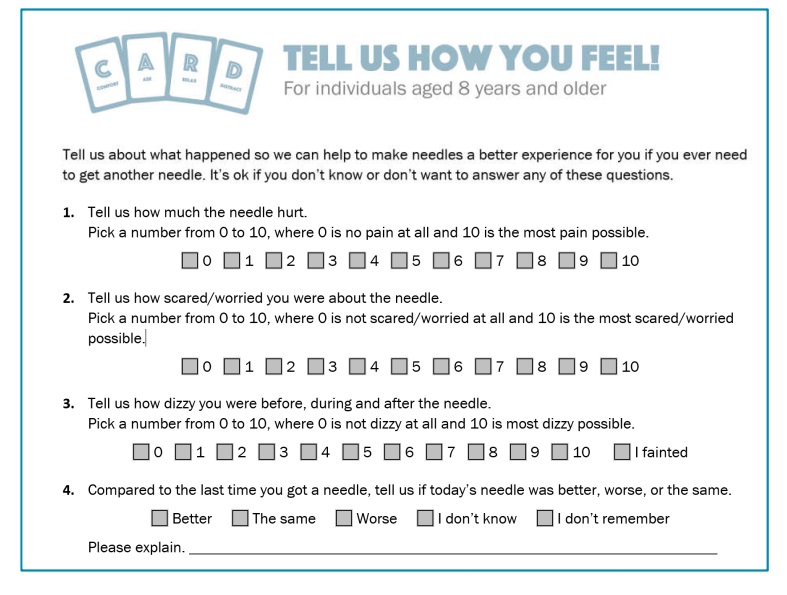
Figure 9: Text description
Tell us how you feel!
For individuals aged 8 and older.
Tell us about what happened so we can help to make needles a better experience for you. If you ever need to get another needle, it's ok if you don't know or don't want to answer any of these questions.
- Tell us how much the needle hurt on a scale of 1 to 10, where 0 is no pain and 10 is the most pain possible.
- Tell us how scared or worried you were about the needle. Pick a number from 0 to 10, where 0 is not scared or worried at all and 10 is the most scared or worried possible.
- Tell us how dizzy you were before, during and after the needle. Pick a number from 0 to 10, where 0 is not dizzy at all and 10 is the most dizzy as possible.
- Compared to the last time you got a needle, tell us if today's needle was better, worse or the same. Select from one of the following choices: better, the same, worse, I don't know or I don't remember. An option to please explain is provided.
Access the CARD system questionnaire (Word document).
CARD outcomes (children)
| Outcomes | Control (n=71) | CARD (n=81) | p-value |
|---|---|---|---|
| Fear, No (%)Table footnote a | 57 (80) | 47 (58) | 0.01 |
| Pain, No (%)Table footnote a | 36 (51) | 26 (32) | 0.03 |
| Fear score, Mean (SD)Table footnote a | 3.7 (3.5) | 2.5 (3.1) | 0.02 |
| Pain score, Mean (SD)Table footnote a | 3.0 (2.5) | 2.4 (2.5) | 0.15 |
| Experience, Median (25th, 75th centile)Table footnote b | 2 (1,2)Table footnote c | 1 (1,2)Table footnote d | 0.01 |
| CARD helped, Median (25th, 75th centile)Table footnote e | N/A | 3 (2,4)Table footnote f | N/A |
Improving the vaccination experience in community pharmacies with CARD. Can Pharm J (Ott) 2023;156(suppl). 2023; In press.
CARD outcomes (parents)
| Outcomes | Control (n+71) | CARD (n=81) | p-value |
|---|---|---|---|
| Child experience, Median (25th, 75th centile)Table 2 footnote a | 2 (1,2)Table 2 footnote b | 1 (1,2)Table 2 footnote c | 0.05 |
| Parent experience, Median (25th, 75th centile)Table 2 footnote a | 2 (1,2)Table 2 footnote b | 1 (1,2)Table 2 footnote d | 0.01 |
| CARD helped, Median (25th, 75th centile)Table 2 footnote e | N/A | 4 (2,4)Table 2 footnote f | N/A |
Improving the vaccination experience in community pharmacies with CARD. Can Pharm J (Ott) 2023;156(suppl). 2023; In press.
Vaccinator-reported behaviors after CARD vs. usual practice (n=6)
| Actions specific to vaccinators | Less Frequency n (%), less |
Frequency n (%), same |
Frequency n (%), more |
|---|---|---|---|
| Obscure needles | 0 (0) | 1 (17) | 5 (83) |
| Provide privacy to patients (door closed) | 0 (0) | 1 (17) | 5 (83) |
| Omit alcohol swab from injection process | 0 (0) | 0 (0) | 6 (100) |
| Ask about preferred coping strategies | 0 (0) | 0 (0) | 6 (100) |
| Invite questions before injection | 0 (0) | 0 (0) | 6 (100) |
Improving the vaccination experience in community pharmacies with CARD. Can Pharm J (Ott) 2023;156(suppl). 2023; In press.
| Children's actions | Less frequency n (%) |
Same frequency n (%) |
More frequency n (%) |
|---|---|---|---|
| Use distraction items/activities | 0 (0) | 0 (0) | 6 (100) |
| Use topic anesthetics | 0 (0) | 1 (17) | 5 (83) |
| Have a support person present (e.g., parent) | 1 (17) | 3 (50) | 2 (33) |
| Sit on parent's lap | 1 (17) | 4 (67) | 1 (17) |
| Injection while lying down | 1 (17) | 3 (50) | 2 (33) |
Improving the vaccination experience in community pharmacies with CARD. Can Pharm J (Ott) 2023;156(suppl). 2023; In press.
Key take-aways from the project
Pharmacists' feedback on CARD after the project:
"Separating the fearful children while they're getting immunized, so the other children are not getting worked up. Offering that privacy, it really helped the whole flow of the day!"
"CARD made the entire process less stressful: for myself, as a vaccinator, for the child, and also for the parents."
"Overall, it's a great process. It's like a prescription that you drop off, you fill, and you dispense. You implement that approach in your workflow."
Improving the vaccination experience in community pharmacies with CARD. Can Pharm J (Ott) 2023;156(suppl). 2023; In press.
| Identify misconceptions and barriers | Address them with facts |
|---|---|
| CARD cannot be accommodated or adds time. |
|
| We can't educate vaccine clients before vaccination day. |
|
| Parents or caregivers may want family members together for all vaccinations. |
|
| Vaccine clients' coping choices not supported by family/caregivers. |
|
| CARD is too costly. |
|
What can you do in your pharmacies?
- CARD checklist.
- Make environment kid friendly.
- Provide distractions.
- Address children directly.
- Support children's decisions.
- Separate children, most fearful first.
- Always provide privacy.
- Hide the needle.
- No alcohol swabs.
- Pharmacist sits beside child.
- Remove extra clothing (sweaters, coats) before entering vaccination room.
CARD resources for younger children under 3 years of age
Comfort positions
Chest to chest: Your child will sit on your lap with their chest against your chest and their legs to either side.
Back to chest: Have your child sit on your lap with their back against your chest. Have their legs on either side of your legs or in between your legs.
Lap sitting: Have your child sit on your lap in a sideways position.
Access the PDF on comfort positions.
Access the CARD checklist PDF for children up to 3 years of age.
For more information about CARD
- SickKids
- Canadian Public Health Association
- CARD Game for Kids (mobile web game for children)
- CARD e-module (education for providers)
- Help Eliminate Pain in Kids and Adults (University of Toronto resources)
- Pediatric Pain, Health and Communication Lab (University of Guelph)
- Vaccination pain management for children: Guidance for health care providers
- Vaccination pain management for adults: Guidance for health care providers
- Canadian Paediatric Society's statement on COVID-19 vaccinations
- World Health Organization 2015 guideline on pain mitigation during vaccination
- Immunization stress-related responses publications
For more PHAC webinars and videos for healthcare professionals, please visit the Government of Canada website: Vaccination webinars and webcasts for health professionals
National Collaborating Centre for Infectious diseases: NCCID hosts the Public Health Agency of Canada webcasts for Health Care Providers
Canadian Vaccination Evidence Resource and Exchange Center website: Public Health Agency of Canada Vaccine Confidence Webinar Series (CANVax)
Public Health Agency of Canada Vaccine Confidence Infobulletin for healthcare professionals
Subscribe to the PHAC Vaccine Confidence InfoBulletin: vaccination@phac-aspc.gc.ca
Previous editions of the Public Health Agency of Canada Vaccine Confidence InfoBulletin on CANVax.ca
Thank you for joining us! Copies of the presentation will be made available on the Public Health Agency of Canada Vaccine Confidence Webinar Series (CANVax).
Thank you for joining us!
Please complete our evaluation of this webcast.
Other CARD resources
Videos from the original research with CARD for kids getting vaccinated:
- Video on school vaccinations: Improving the vaccination experience at school
- Video on school vaccinations: What you need to know about vaccines at school
- Video on school vaccinations: The CARD System: play your power CARD
- CARD video playlist (released September 2021)
References
- Improving the vaccination experience in community pharmacies with CARD. Can Pharm J (Ott) 2023;156(suppl). 2023; In press.
- McMurtry, C. M., Pillai Riddell, R., Taddio, A., Racine, N., Asmundson, G. J., Noel, M., HELPinKids&Adults Team. (2015). Far from "just a poke": Common painful needle procedures and the development of needle fear. The Clinical Journal of Pain, 31(10 Suppl), S3-11. doi:10.1097/AJP.0000000000000272
- Taddio, A., McMurtry, C. M., Shah, V., Riddell, R. P., Chambers, C. T., Noel, M.,... HELPinKids&Adults. (2015). Reducing pain during vaccine injections: Clinical practice guideline. CMAJ : Canadian Medical Association Journal = Journal De l'Association Medicale Canadienne, 187(13), 975-982. doi:10.1503/cmaj.150391
- Taddio, A., Ipp, M., Thivakaran, S., Jamal, A., Parikh, C., Smart, S.,... Katz, J. (2012): Survey of the prevalence of immunization non-compliance due to needle fears in children and adults. Vaccine, 30(32), 4807-4812. [doi]
- Taddio, A., McMurtry, C. M., Bucci, L. M., MacDonald, N., Ilersich, A. N. T., Ilersich, A. L. T.,... Alderman, L. (2019). Overview of a knowledge translation (KT) project to improve the vaccination experience at school: The CARD system. Paediatrics & Child Health, 24(Supplement_1), S3-S18. doi:10.1093/pch/pxz025
